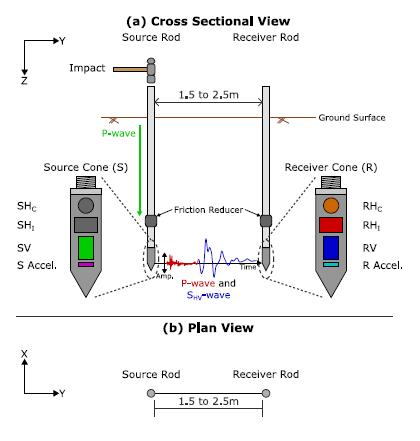The direct push downhole seismic test (DPCH) is conducted by vertically pushing two separate seismic probes into the ground at a set horizontal distance apart. CPT rigs are used to push the probes, so two rigs are generally required to do this test. Typically, the horizontal spacing between the probes is 1.5 m to 2.5 m and the tests are conducted at depth intervals of around 200 mm to 500 mm. Each probe has a set of triaxial geophones for measuring primary (pressure) waves and shear waves. One probe acts as the source and the other as the receiver. The seismic wave is generated by hitting the top of the rod string of the source probe. The signal so generated is received at the source probe. The pressure wave and shear wave velocities can then be determined at each depth increment by picking arrival times in the recorded waveforms. The distance between the probes can be verified from inclinometer readings in the probes.

This method was developed by Brady Cox and Liam Wotherspoon and others from the University of Texas and the Universities of Auckland and Canterbury. At Ground Investigation we work in association with the Universities of Auckland and Canterbury when carrying out these tests.
The DPCH tests are suited for near surface soils and are particularly useful in ground improvement assessment. Another application for the test is the identification of the depth to fully-saturated soils.

